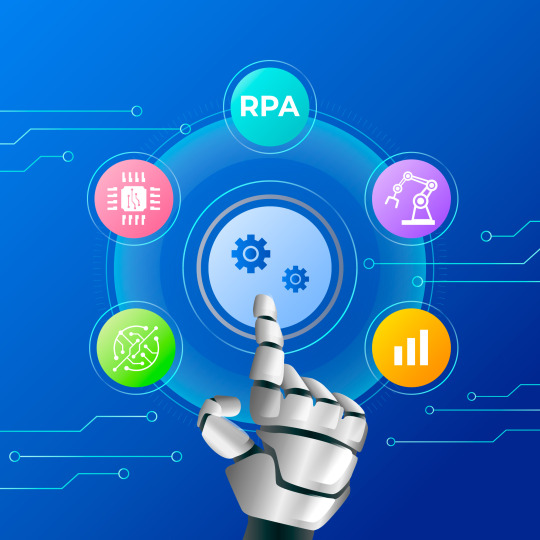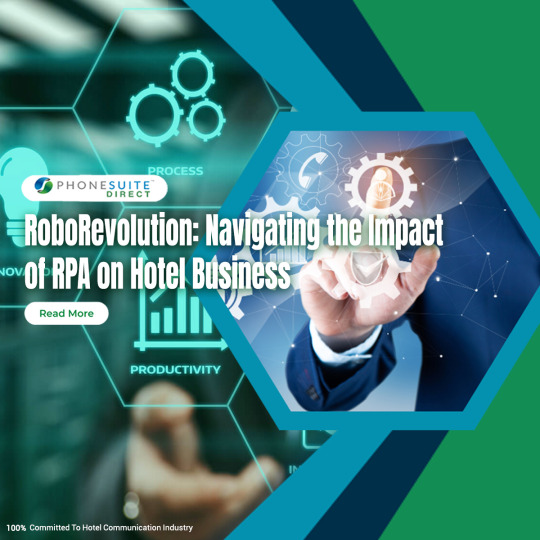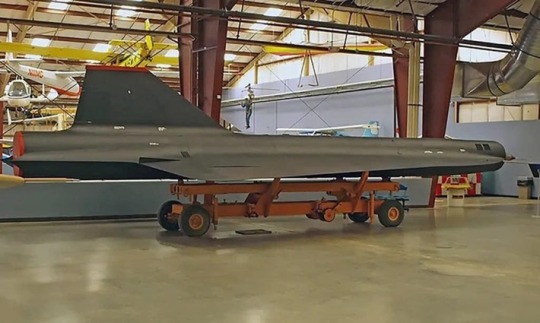#rpa system
Text
Unlocking Efficiency and Innovation: The Role of Robotic Process Automation (RPA)

In today's fast-paced and competitive business environment, organizations are constantly seeking ways to improve efficiency, reduce costs, and increase productivity. Robotic Process Automation (RPA) has emerged as a powerful tool that can help businesses achieve these objectives.
What is Robotic Process Automation (RPA)?
Robotic Process Automation (RPA) is a technology that allows businesses to automate repetitive, rule-based tasks. It uses software robots, also known as "bots," to mimic human actions and interact with digital systems. These bots can log into applications, navigate through screens, input data, and complete tasks just like humans would.
The Role of RPA in Business:
RPA can be used to automate a wide range of tasks across various industries and departments. Here are some examples:
Finance and Accounting: Automating tasks such as accounts payable and receivable, invoice processing, and financial reporting.
Customer Service: Automating tasks such as answering FAQs, resolving customer inquiries, and processing orders.
Human Resources: Automating tasks such as onboarding new employees, processing payroll, and managing benefits.
IT: Automating tasks such as provisioning accounts, managing user access, and deploying software updates.
Impact of RPA on Businesses:
Implementing RPA can offer numerous benefits to businesses, including:
Increased efficiency and productivity: RPA can automate time-consuming and tedious tasks, freeing up employees to focus on more strategic and value-added activities.
Reduced costs: RPA can help businesses save money on labor costs, as well as reduce errors and compliance risks.
Improved accuracy and compliance: RPA bots are programmed to follow specific rules and procedures, which can help to improve accuracy and compliance with regulations.
Enhanced process visibility and control: RPA provides businesses with a clear view of their processes, which can help them identify and address bottlenecks.
Improved customer satisfaction: RPA can help businesses improve customer satisfaction by automating tasks such as order processing and customer service interactions.
RPA Services:
Implementing RPA successfully requires a partner with expertise in the technology and a deep understanding of business processes. A comprehensive RPA solution should include the following services:
Document AS-IS Process: This involves mapping out the existing process to identify areas for automation.
Design & Development of Bots, workflows, and forms for process automation: This includes designing and developing the software robots that will automate the tasks.
Bot license (We will use the appropriate underlying technology): This provides access to the software robots and the underlying technology platform.
Infrastructure: This includes setting up the necessary infrastructure to support the Robotic Process Automation (RPA) solution.
Production Deployment of the Bots: This involves deploying the bots to production and monitoring their performance.
RPA support: This includes ongoing support for the RPA solution, such as troubleshooting and maintenance.
Test & Deploy bots to production: This involves testing the bots in a production environment and making any necessary adjustments before they are deployed to full production.
Configuration data changes: This involves making changes to the configuration data of the bots as needed.
Password updates: This involves updating the passwords of the bots as needed.
Errors in executing the Bots: This involves resolving errors that occur during the execution of the bots.
Determining the “root cause” of a recurring issue or incident & recommendations: This involves identifying the root cause of a recurring issue or incident and recommending solutions to prevent it from happening again.
Infrastructure/application related issues: This involves resolving issues with the infrastructure or applications that the bots are interacting with.
Conclusion:
RPA is a powerful technology that can have a significant impact on businesses of all sizes. By automating repetitive tasks, RPA can help businesses improve efficiency, reduce costs, and increase productivity. However, it is important to choose a reputable Robotic Process Automation (RPA) companies with the expertise and experience to help you implement a successful RPA solution.
Ready to embrace the power of RPA?
Contact us today to learn more about how RPA can help your business achieve its goals.
#robotic process automation#robotic process automation rpa#rpa automation#robotic process automation software#rpa software#robotic process automation companies#robotic process automation technology#robotic process automation in healthcare#robotic process automation in banking#rpa solution#robotic process automation for finance#process automation solution#robotic process automation services#robotic process automation for insurance#rpa system#what is rpa automation#robotic process automation solution#robotic process automation benefits#robotic process automation consulting#robotic process automation consultant#rpa service provider#rpa consulting services
2 notes
·
View notes
Text
Benefits of RPA

The organization implemented an RPA system that automated key processes, including patient registration, insurance verification, and claim submission. As a result of the RPA implementation, the healthcare organization significantly reduced the time it took to process insurance claims, resulting in faster reimbursements and improved cash flow.
Website: https://skill-mine.com/service/robotic-process-automation-services/
0 notes
Text
How does RPA Robotic Automation work for the travel industry?
Introductions
These days, it has become more important to use RPA (Robotic Automation Process) especially for travel agencies business operators business to flourish.
A few years ago, RPA (Robotic Automation Process) became one of the most popular software options in the travel and tourism sectors. Whereas it is the modern solution for modern technical issues.
RPA is that necessary software that every business operator has to opt for. There are some certain and variable reasons for which every business operator has to go for it. This software has enough capacity to hold and manage your entire business.
In the lower portion, we discuss the complete guide to RPA (Robotic Process Automation). You have to stay on this blog till the end.

What role does RPA play?
Let’s come to the point that RPA is the most essential part of every business to deal with trouble and mess. RPA stands for Robotic Automation, which is how it works. This software has some advanced functionality that can manage your entire business mess in a few easy steps without any human interference. RPA (Robotic Process Automation) has versatile benefits.
Which Company RPA is better to choose?
SoftwareXprts RPA Service Provider (Robotic Process Automation) has amazing features and performing functionality, which can be very favorable for online travel agencies and tour operators. where there has always been a messy workload.
With the aid of RPA, business operators can manage all their work within a few clicks. This software will reduce face-to-face interactions and also reduce the workload.
Which types of Services RPA Provides?
RPA is robotic process automation that enhances and has the capability to manage your entire business with the help of this RPA Service Provider. You can take care of your business 24/7. Also, you can earn a valuable response from the RPA.
Here is the list of the facility that RPA Provides:-
You can earn a long queue of digital customers via this RPA software.
RPA has the ability to automate your business's performance.
Whereas, with the help of the scenarios you’re booking, it will become easier.
Through the aid of this RPA Software, you will get notified of every notification of booking which is done by the Customer for the booking purpose.
Features of the RPA (Robotic Process Automation)
Our Automated and digital software is available as cloud services and Amadeus.
Any Travel Platform
Queue Management
Remove HX Segments
Check Airline Comments
Check Schedule Changes
Low –Fare finder-Post booking (24 hours of Window).
It Basis on remarks set in PNR
Data scrapping bots
Convenient & Reliable functions
What is the benefit for travel industry operators to use this RPA software?
A fast ROI via the help of this software.
And convenient access.
It can maximize your stress of handling the work, RPA is online.
It increases your productivity in your business.
You will get notified about every notification from the client.
Demo Version
SoftwareXprts has also introduced demo editions of the RPA software, so now customers can freely perpetuate each and every single functionality and feature of our RPA software. Therefore, our software has a very user-friendly interface that can be operated by a novice as well. Hence, our demo edition is completely free, so our prestigious customers can evaluate all its functions.
Conclusions
Now we are ending this blog with a conclusion, submitting all the information in a small end up. This RPA is a good solution for travel and tour operators who have their travel businesses online. We have completed this blog with plenty of information about our RPA software, so you will not have any difficulty evaluating our services. According to today’s technical issues, which are faced by the travel agencies regularly for various purposes?
We hope that you will appropriately understand what we are trying to say about our software. We aim to help every travel and tour operator escalate their business with the help of our RPA software.
#RPA#RPA service provider#SoftwareXprts#best travel technology company#best travel portal development company#travel booking software#online ticket booking system#travel mid office solutions
2 notes
·
View notes
Text
B2C Travel Portal - B2C Travel Portal Development

SoftwareXprts is a team of 50+ experts working towards becoming a website designing & Development company in Canada, India, the USA, UAE & Saudi Arabia. We offer online travel portal development, best travel api provider, and online ticket booking system.
Our Services:-
best travel technology company
best travel portal development company
b2b travel portal development
b2c travel portal development
flight booking api
flight api
hotel api integration
car booking api
gds api integration
travel mid office solutions
online ticket booking system
#b2b travel portal development#b2c travel portal development#b2b travel portal#b2c travel portal#online b2b travel portal#flight booking api#flight api#hotel api integration#car booking api#car rental api#best travel api provider#gds integration#gds api integration#amadeus api development#travel mid office solutions#travel software solutions#best travel technology company#online travel portal development#RPA service provider#online ticket booking system#best travel portal development company#travel booking software
2 notes
·
View notes
Text

The hotel industry, like many others, can greatly benefit from implementing robotic process automation. In this blog post, you’ll learn why and how you should start leveraging RPA in your hotel business and what benefits it can bring. Read More...
#voip technology#business phones#phonesuite direct#voip advantages#voip phone#hotel phone system#pbx system#hotel hospitality#phonesuite dealers#VoIP Technology#Hotel Phone System#Business Phones#SIP Trunking#Aution#RPA Aution#hospitality industry#PBX Communications#Voice Call#PBX System#Telephony Solutions#VoIP Phone
0 notes
Text

Humanware HR software gives your team a single place to manage all of your HR needs with modern HR Tools which help to make light work of heavy tasks. Quick and hassle free payroll process, Less Stress and More Productivity.
Schedule demo : https://www.humanwaretechnology.com/Best-HR-Software.html
#hrms#hrms solution#hrms system#hr software#hr#payroll#hrms payroll software#automation#rpa software#hr system#hrms company#management
0 notes
Text
Revolutionize Your Business Processes with Our ERP Solutions
Enterprise Resources Planning (ERP) solutions integrate all your various business processes needed to run a company in a single system for all departments, such as finance, manufacturing, HR, supply chain, services, and procurement.
It makes it easier for your employees and clients to work together to increase your reach and revenue by building new business models. ERP will help your business identify what you can do best and where to do better to boost productivity.

Enterprise Resource Planning (ERP) Implementation
On-Premises ERP:
On-premises ERP solutions are installed locally on your computer's hardware and servers, under your control, and managed by your IT Staff. It cannot be accessed through the internet and also cannot be used outside of a physical workspace but can be used on different mobile and handheld devices.
Cloud ERP:
Cloud ERP, also called, Software-as-a-Service (SaaS), is provided as a service. In this deployment, a company's software and related data are managed by the ERP vendor and accessed by customers using a web browser. Companies can access their mission-critical applications at any time, from any location – and it offers the ability to scale and innovate.
Business Advantage of Enterprise Resource Planning ERP)
Enhanced Productivity
ERP system will boost productivity by automating many basic, repetitive tasks, allowing employees to work on other projects that bring more business value to the organization. Employees can complete tasks faster by making processes more straightforward and reducing the time spent searching for the needed information.
Financial organization can enhance their data like budget estimates and cash flow management, enabling them to make informed and critical business decisions through Enterprise Resource Planning (ERP).
Some of the features of Enterprise Resource Planning in finance are:
Generating financial reports
2. Conducting profitability analyses
3. Performing revenue management
4. Managing routine transactions
5. Expense reporting and management
6. Payroll processing
7. Financial reporting
8. Automating manual data entry
Manufacturing industries can achieve greater simplicity, efficiency, insight, collaboration, transparency, and compliance across projects, production, procurement, logistics, and finance
ERP features for manufacturing Industries:
Inventory management:
ERP can streamline resources for inventory tracking, data analysis, and replenishment.
Supply chain:
ERP enables the organization to vendor performance tracking and pulls data from internal and external sources for efficient supply chain planning and management.
Maintenance:
Enables effective maintenance by centralizing scheduling, ticketing, and work order management, along with robust data tracking and analytics to improve maintenance effectiveness.
Equipment performance tracking:
ERP can track and analyze equipment performance data from IoT sensors and reports, enabling you to inform proactive maintenance.
Quality assurance:
Enterprise resource planning can track QA results, creating vast data stores over time that will identify the maintenance requirements.
Purchasing:
Purchasing can be easily organized and can operate with visibility into other related areas of the operation.
Human Resources:
ERP enables HR functions such as performance reviews, goal tracking, etc.
We use Analytical frameworks to evaluate the impact of the factors affecting your company's systems, technology, business process, and environment. With our deep domain expertise in Microsoft ERP and SAP ERP, our consultants engage effectively with our customers in integrating, designing, building, and testing winning Microsoft and SAP business solutions.
#Benefits of ERP#ERP software#RPA ERP#ERP benefits#Enterprise Resource Planning#erp software#Enterprise Resource Planning systems#Cloud ERP solutions
0 notes
Text
Future accounting software: Developing trends

Accounting software has come a long way since the days of manual bookkeeping. As technology continues to advance, so too does the software that companies use to manage their finances. In 2023, several emerging trends are shaping the future of accounting software. Read More: Future accounting software: Developing trends
#accounting firms#accounting firms in Delhi#outsourced accounting firms#accounting websites in India#top accounting firms in Delhi#top accounting companies in India#top accounting methods#accounting benefits#Artificial Intelligence#Machine Learning#financial reporting#bookkeeping services#cloud-based accounting system#RPA
0 notes
Text
Online B2B Travel Portal - Online Travel Portal Development
Software Xprts Services offers a complete online travel portal development for travel agencies like travel booking software, car rental api, b2c travel portal and b2b travel portal development.

Visit More -
b2b travel portal development
b2c travel portal development
b2b travel portal
b2c travel portal
online b2b travel portal
flight booking api
flight api
hotel api integration
car booking api
car rental api
best travel api provider
gds integration
gds api integration
amadeus api development
travel mid office solutions
travel software solutions
best travel technology company
online travel portal development
RPA service provider
online ticket booking system
best travel portal development company
travel booking software
#b2b travel portal development#b2c travel portal development#b2b travel portal#b2c travel portal#online b2b travel portal#flight booking api#flight api#hotel api integration#car booking api#car rental api#best travel api provider#gds integration#gds api integration#amadeus api development#travel mid office solutions#travel software solutions#best travel technology company#online travel portal development#RPA service provider#online ticket booking system#best travel portal development company#travel booking software
1 note
·
View note
Text
robotic automation systems
Robotic Process Automation is a new technology that allows to develop bot and automate your applications via low code and no code method.
https://mobolutions.com/2022/11/02/automation-with-sap-intelligent-robotic-process-automation/
#robotic automation systems#robotic process automation rpa software#artificial intelligence robotic process automation
0 notes
Text
Moodle Developer
Hi Recruiters,
I have excellent candidate specializing in Moodle.
Having 5 years + development experience of implementing Moodle (PHP) based Learning Management System for various clients.
Available for working remote, full time/contract.
Available immediately.
contact me for more details

View On WordPress
0 notes
Text



Wait, there’s more ! D-21 found. D 21 was created by the Skunk Works designer Kelly Johnson. It is a drone capable of going faster than an SR 71. It’s purpose was to go deep into China and photograph their nuclear weapons facility.
1604 Hrs. December 20, 2009. In the Back Storage Yard of the Pima Air & Space Museum Outside Tucson, Arizona.
I pet airplanes when I can. I’m not exactly sure why, maybe to be able to say I did. Maybe to try to gain some tactile sense of their history. Maybe to absorb something from them, if such a thing is possible. Maybe so that, when I am old and dying, I can reflect back on what it felt like to stand next to them and touch them. I don’t know why I touch them and stroke them, but I do.
The D-21 is dusty and warm in the late afternoon Arizona sun. Its titanium skin is hard, not slightly forgiving like an aluminum airplane. It gives away nothing. Silent. Brooding. After I touch it my hand came away with some of the dust from it. I don’t wipe it off. Sometime later in the coming years, the D-21B drone, number 90-0533, is brought inside the vast restoration facility at the Pima Air & Space Museum and beautifully restored. Now it lies in state, on display inside the museum.
But when I first found it sitting abandoned in the storage yard, dusty and baking in the Sonoran Desert sun, it felt like its warm titanium skin still had some secret life left in it.
The D-21 is truly a “drone”, not a remotely piloted aircraft (RPA). Its flight plan is programmed into a guidance system. It is launched from a mothership launch aircraft at speed and altitude. It flies a predetermined spy mission from 17 miles above the ground and flashes over at three times the speed of sound. It photographs massive swaths of land with incredible detail and resolution. And because of its remarkably stealthy shape, no one will ever know it was there.
I found part of an article by the Aviationist on Google . TOM DEMERLY
@HABUBRATS71 via X
24 notes
·
View notes
Text
CFP: AI and Fandom
Unfortunately, this special issue will not be moving forward. All submitted pieces are being considered for our general issue.
Due in part to well-publicised advancements in generative AI technologies such as GPT-4, there has been a recent explosion of interest in – and hype around – Artificial Intelligence (AI) technologies. Whether this hype cycle continues to grow or fades away, AI is anticipated to have significant repercussions for fandom (Lamerichs 2018), and is already inspiring polarised reactions. Fan artists have been candid about using creative AI tools like Midjourney and DALL-E to generate fan art, while fanfiction writers have been using ChatGPT to generate stories and share them online (there are 470 works citing the use of these tools on AO3 and 20 on FanFiction.net at the time of writing). It is likely the case that even greater numbers of fans are using such tools discreetly, to the consternation of those for whom this is a disruption of the norms and values of fan production and wider artistic creation (Cain 2023; shealwaysreads 2023). AI technology is being used to dub movies with matching visual mouth movements after filming has been completed (Contreras 2022), to analyse audience responses in real-time (Pringle 2017), to holographically revive deceased performers (Andrews 2022; Contreras 2023), to build chatbots where users can interact with a synthesised version of celebrities and fictional characters (Rosenberg 2023), to synthesise celebrities’ voices (Kang et al. 2022; Nyce 2023), and for translation services for transnational fandoms (Kim 2021).
Despite the multiple ways in which AI is being introduced for practical implementations, the term remains a contested one. Lindley et al (2020) consider “how AI simultaneously refers to the grand vision of creating a machine with human-level general intelligence as well as describing a range of real technologies which are in widespread use today” (2) and suggest that this so called ‘definitional dualism’ can obscure the ubiquity of current implementations while stoking concerns about far-future speculations based on media portrayals. AI is touted as being at least as world-changing as the mass adoption of the internet and, regardless of whether it proves to be such a paradigm shift, the strong emotions it generates make it a productive site of intervention into long-held debates about: relationships between technology and art, what it means to create, what it means to be human, and the legislative and ethical frameworks that seek to determine these relationships.
This special issue seeks to address the rapidly accelerating topic of Artificial Intelligence and machine learning (ML) systems (including, but not limited to Generative Adversarial Networks (GANs), Large Language Models (LLMs), Robotic Process Automation (RPA) and speech, image and audio recognition and generation), and their relationship to and implications for fans and fan studies. We are interested in how fans are using AI tools in novel ways as well as how fans feel about the use of these tools. From media production and marketing perspectives we are interested in how AI tools are being used to study fans, and to create new media artefacts that attract fan attention. The use of AI to generate transformative works challenges ideas around creativity, originality and authorship (Clarke 2022; Miller 2019; Ploin et al. 2022), debates that are prevalent in fan studies and beyond. AI-generated transformative works may present challenges to existing legal frameworks, such as copyright, as well as to ethical frameworks and fan gift economy norms. For example, OpenAI scraped large swathes of the internet to train its models – most likely including fan works (Leishman 2022). This is in addition to larger issues with AI, such as the potential discrimination and bias that can arise from the use of ‘normalised’ (exclusionary) training data (Noble 2018). We are also interested in fan engagement with fictional or speculative AI in literature, media and culture.
We welcome contributions from scholars who are familiar with AI technologies as well as from scholars who seek to understand its repercussions for fans, fan works, fan communities and fan studies. We anticipate submissions from those working in disparate disciplines as well as interdisciplinary research that operates across multiple fields.
The following are some suggested topics that submissions might consider:
The use of generative AI by fans to create new forms of transformative work (for example, replicating actors’ voices to ‘read’ podfic)
Fan responses to the development and use of AI including Large Language Models (LLMs) such as ChatGPT (for example, concerns that AO3 may be part of the data scraped for training models)
Explorations of copyright, ownership and authorship in the age of AI-generated material and transformative works
Studies that examine fandoms centring on speculative AI and androids, (e.g. Her, Isaac Asimov, WestWorld, Star Trek)
Methods for fan studies research that use AI and ML
The use of AI in audience research and content development by media producers and studios
Lessons that scholars of AI and its development can learn from fan studies and vice versa
Ethics of AI in a fan context, for example deepfakes and the spread of misinformation
Submission Guidelines
Transformative Works and Cultures (TWC, http://journal.transformativeworks.org/) is an international peer-reviewed online Gold Open Access publication of the nonprofit Organization for Transformative Works, copyrighted under a Creative Commons License. TWC aims to provide a publishing outlet that welcomes fan-related topics and promotes dialogue between academic and fan communities. TWC accommodates academic articles of varying scope as well as other forms, such as multimedia, that embrace the technical possibilities of the internet and test the limits of the genre of academic writing.
Submit final papers directly to Transformative Works and Cultures by January 1, 2024.
Articles: Peer review. Maximum 8,000 words.
Symposium: Editorial review. Maximum 4,000 words.
Please visit TWC's website (https://journal.transformativeworks.org/) for complete submission guidelines, or email the TWC Editor ([email protected]).
Contact—Contact guest editors Suzanne Black and Naomi Jacobs with any questions before or after the due date at [email protected].
Due date—Jan 1, 2024, for March 2025 publication.
Works Cited
Andrews, Phoenix CS. 2022. ‘“Are Di Would of Loved It”: Reanimating Princess Diana through Dolls and AI’. Celebrity Studies 13 (4): 573–94. https://doi.org/10.1080/19392397.2022.2135087.
Cain, Sian. 2023. ‘“This Song Sucks”: Nick Cave Responds to ChatGPT Song Written in Style of Nick Cave’. The Guardian, 17 January 2023, sec. Music. https://www.theguardian.com/music/2023/jan/17/this-song-sucks-nick-cave-responds-to-chatgpt-song-written-in-style-of-nick-cave.
Clarke, Laurie. 2022. ‘When AI Can Make Art – What Does It Mean for Creativity?’ The Observer, 12 November 2022, sec. Technology. https://www.theguardian.com/technology/2022/nov/12/when-ai-can-make-art-what-does-it-mean-for-creativity-dall-e-midjourney.
Contreras, Brian. 2022. ‘A.I. Is Here, and It’s Making Movies. Is Hollywood Ready?’ Los Angeles Times, 19 December 2022, sec. Company Town. https://www.latimes.com/entertainment-arts/business/story/2022-12-19/the-next-frontier-in-moviemaking-ai-edits.
———. 2023. ‘Is AI the Future of Hollywood? How the Hype Squares with Reality’. Los Angeles Times, 18 March 2023, sec. Company Town. https://www.latimes.com/entertainment-arts/business/story/2023-03-18/is-a-i-the-future-of-hollywood-hype-vs-reality-sxsw-tye-sheridan.
Kang, Eun Jeong, Haesoo Kim, Hyunwoo Kim, and Juho Kim. 2022. ‘When AI Meets the K-Pop Culture: A Case Study of Fans’ Perception of AI Private Call’. In . https://ai-cultures.github.io/papers/when_ai_meets_the_k_pop_cultur.pdf.
Kim, Judy Yae Young. 2021. ‘AI Translators and the International K-Pop Fandom on Twitter’. SLC Undergraduate Writing Contest 5. https://journals.lib.sfu.ca/index.php/slc-uwc/article/view/3823.
Lamerichs, Nicolle. 2018. ‘The next Wave in Participatory Culture: Mixing Human and Nonhuman Entities in Creative Practices and Fandom’. Transformative Works and Cultures 28. https://doi.org/10.3983/twc.2018.1501.
Leishman, Rachel. 2022. ‘Fanfiction Writers Scramble To Set Profiles to Private as Evidence Grows That AI Writing Is Using Their Stories’. The Mary Sue, 12 December 2022. https://www.themarysue.com/fanfiction-writers-scramble-to-set-profiles-to-private-as-evidence-grows-that-ai-writing-is-using-their-stories/.
Lindley, Joseph, Haider. Akmal, Franziska Pilling, and Paul Coulton. 2020. ‘Researching AI legibility through design’. In Proceedings of the 2020 CHI Conference on Human Factors in Computing Systems (pp. 1-13). https://doi.org/10.1145/3313831.3376792
Miller, Arthur I. 2019. The Artist in the Machine: The World of AI-Powered Creativity. Cambridge, Massachusetts: MIT Press.
Noble, Safiya Umoja. (2018) Algorithms of Oppression: How Search Engines Reinforce Racism. New York, USA: New York University Press.
Nyce, Caroline Mimbs. 2023. ‘The Real Taylor Swift Would Never’. The Atlantic, 31 March 2023. https://www.theatlantic.com/technology/archive/2023/03/ai-taylor-swift-fan-generated-deepfakes-misinformation/673596/.
Ploin, Anne, Rebecca Eynon, Isis Hjorth, and Michael Osborne. 2022. ‘AI and the Arts: How Machine Learning Is Changing Artistic Work’. Report from the Creative Algorithmic Intelligence Research Project. University of Oxford, UK: Oxford Internet Institute. https://www.oii.ox.ac.uk/news-events/reports/ai-the-arts/.
Pringle, Ramona. 2017. ‘Watching You, Watching It: Disney Turns to AI to Track Filmgoers’ True Feelings about Its Films’. CBC, 4 August 2017. https://www.cbc.ca/news/science/disney-ai-real-time-tracking-fvae-1.4233063.
Rosenberg, Allegra. 2023. ‘Custom AI Chatbots Are Quietly Becoming the next Big Thing in Fandom’. The Verge, 13 March 2023. https://www.theverge.com/23627402/character-ai-fandom-chat-bots-fanfiction-role-playing.
shealwaysreads. 2023. “Fascinating to see…” Tumblr, March 28, 2023, 11:53. https://www.tumblr.com/shealwaysreads/713032516941021184/fascinating-to-see-a-take-on-a-post-about-thehttps://www.tumblr.com/androidsfighting/713056705673592832?source=share
#cfp#twc#otw#fan studies#fandom#academia#academic journals#academic chatter#call for papers#call for submissions#ai#artifical intelligence#machine learning#LLMs#chatgpt#ai fanfic#ai fanart#ai ethics#data ethics
13 notes
·
View notes
Note
How does the education system in the Everrealm even work. Elena, Mateo and Naomi are not in school even though they are secondary school age. All we see is primary school for Isabel, the StF kids
I imagine the different Kingdoms have their own approaches to education, like how real world countries have different education systems. I'm assuming most of the kingdoms require primary education and have varying degrees of requirement for secondary education, with access to tertiary education for those that would need higher education in more specialized subjects.
Enchancia we know has Royal Prep and the village school for primary education, with the former being specifically for royals from a variety of kingdoms. The other kingdoms presumably have their own village schools as well for non-royal folks. Royal Prep and the village school have different curriculum, with RPA teaching magic and the village school teaching construction, as examples. Hexley Hall is a magic academy that seems to cover primary, secondary, and tertiary education for sorcerers considering Cedric says he studied there for 15 years. Other primary schools introduced in StF include the Junior Knights Academy and Westloch.
I don't think we really see any secondary school students in StF, but we do learn a little about secondary education, at least for the upper class, when the Royal Prep students get sent to pick a school to attend after RPA graduation in The Royal School Fair. Like Royal Prep, these schools don't seem to be restricted by kingdom. So at least in the "Eastern Hemisphere" EverRealm, royals seem to be educated together for primary school before being split up for more specialized secondary school.
I don't remember if its ever made clear how secondary education works for normal kids, nor how admission into Hexley Hall works as opposed to just going to a regular school. Considering StF is entirely focused on primary school aged kids, it makes sense that we wouldn't learn a whole lot about what happens afterward.
We learn even less about education in the "Western Hemisphere" EverRealm in Elena of Avalor, since unlike StF, EoA's focus isn't on the characters being in school. Royal education doesn't seem to be as centralized in Avalor as it is in Enchancia (& Enchancia's neighbors), since Isabel was being privately tutored in the castle before going to school. There also doesn't seem to be a specific school for royals, since when she does start attending school, she just goes to the regular school in the city. We also know Avalor has tertiary education in the form of the Science Academy, and there are presumably other specialist schools as well. Esteban mentions a "royal academy" when he says he's bringing in professional dancers for Naomi's birthday in My Fair Naomi, but this is never really elaborated on.
As to why we don't see the teens in school - I touched briefly on this in my magic in Avalor post, but my headcanon is that education in Avalor is only required through lower secondary education (through the end of 9th grade for Americans). This is based off the fact that upper secondary school was only made mandatory in Mexico in 2012. Elena presumably had private tutors growing up (seeing as Isabel canonically did), so we wouldn't see her going to school even if she was still studying. Mateo and Naomi, then, would've been upper secondary school-aged at the start of the show, so it's possible that they just dropped out once they got their jobs at the palace.
It might also be possible for them to just still be in school during the run of the show. We don't see every detail of their lives, and the school day in a lot of Latin America tends to be structured around the morning, with classes ending early so students can go home for lunch. They could be going to school in the morning and then heading to the palace in the afternoons, and the episodes where we see them hanging around at other hours are weekends or holidays. I mean, the show starts during summer break, so it wouldn't be an issue for a few months anyway.
#elena of avalor#eoa#sofia the first#stf#ditto answers#I was originally gonna add some school-related amigo headcanons at the end#but this post is already very long lmao
33 notes
·
View notes
Text

Know about the importance of RPA in IT process automation to enhance productivity, minimize errors, and to increase overall business efficiency
#Research Robotic Process Automation#RPA#Robotics Systems#RPA solutions#RPA platform#RPA software providers#RPA implementation#RPA tools#RPA technologies
0 notes
Text
10 Advance accounting methods for companies

In today's rapidly changing corporate landscape, companies must adopt advanced bookkeeping and accounting methods to stay competitive and achieve financial success. As we move into 2023, businesses should consider incorporating several new and innovative accounting practices into their financial strategies. Read More: 10 Advance accounting methods for companies
#accounting firms#accounting firms in Delhi#outsourced accounting firms#accounting websites in India#top accounting firms in Delhi#top accounting companies in India#top accounting methods#accounting benefits#Artificial Intelligence#Machine Learning#financial reporting#bookkeeping services#cloud-based accounting system#RPA
0 notes